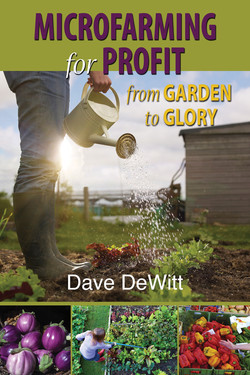Читать книгу Microfarming for Profit - Dave DeWitt - Страница 12
На сайте Литреса книга снята с продажи.
ОглавлениеBABY GINGER
About the Crop
Baby ginger is precisely what its name implies: immature rhizomes that lack the tough skin and potent pungency of store-bought mature ginger. It does not require peeling and does not have a fibrous center, so cooks can simply chop it and use it. Baby ginger as a culinary ingredient is unfamiliar to most consumers and even chefs, so let them know in advance about your coming crop to get them interested in future purchases. During harvest time, it’s important to educate the public on using and storing the baby ginger that they purchase, so you should create an information sheet with basic uses and a couple of recipes.
Ginger is part of the genus Zingiber, which has about a hundred species of perennial plants, many of which are grown as ornamentals. The different species of Zingiber have many culinary uses—for example, the shoots and flowers of Zingiber mioga, the Japanese ginger, are used fresh or pickled as a flavoring in Japanese cuisine, such as the familiar accompaniment to sushi and sashimi.
The principal cultivated ginger is Zingiber officinale, native to tropical Asia, which is a deciduous perennial with thick, branching rhizomes, upright stems, and long, pointed leaves. The flowers are quite lovely—yellow-green with purple and yellow lips. The plant can grow up to four feet tall. The flavor and heat levels vary greatly, as Australian spice expert Ian Hemphill notes: “The flavour will be similarly tangy, sweet, spicy and warm to hot, depending upon when it has been harvested, as to a large degree early harvested [baby] ginger is sweet and tender, while later harvested rhizomes are more fibrous and pungent.”
The volatile oils causing the pungency are gingerols and shogaols. The shogaols appear when ginger is dried and they are much more pungent, so dried ginger is hotter than fresh. It also has less water, so the pungency is more concentrated. Gingerol is commonly used to treat poor digestion, heartburn, and motion sickness.
Baby ginger.
Photo courtesy of Sunbelt Archives.
Pros
Basically, for ginger, the pros are the value-added products that come from the crop. There are two methods of processing ginger to make value-added products. One is to preserve it in brine, syrup, or in crystallized form. The other is to dry it and then, optionally, to grind it into powder.
Pickled ginger is made from fresh rhizomes that are sliced as thin as paper, then placed in a vinegar solution. The acetic acid in the vinegar turns the ginger pink. In Japan, pickled ginger is known as gari and it is considered a palate refresher between courses, and it is commonly served with sushi and sashimi.
Dried ginger is made from the more mature rhizomes, which are peeled by the farmers and left to dry in the sun, which is not the cleanest method. Increasingly, more ginger is being furnace-dried. After drying, the rhizomes are ground into powder and bottled.
Cons
The plants require not only a long growing period (which, on a farm, especially a microfarm, can easily monopolize valuable real estate) but also ample amounts of water and just the right soil temperature. Baby ginger is fussy and it likes constant warmth but not excessive heat. The plant generally requires soil between fifty and ninety degrees, which essentially means that the east coast states are not the best place to grow it unless you use a greenhouse, tunnels, or hoop houses. The late winter and early spring months are too cold, and the summers are much too hot. It is possible to grow baby ginger in containers, but the yields are too small to make this practical.
The storage time after harvest is much shorter for baby ginger than it is for mature ginger, which can often last for months in the store or your refrigerator. Baby ginger can be stored at room temperature for only about two to three weeks after harvest. This limits the market season, but also means that competition for the crop is small and it cannot be shipped from overseas producers. Ginger is one of the most fragile of all the spicy ingredients because its heat fades so quickly, especially after processing and when cooked.
Baby ginger is becoming so popular as a specialty crop that the main seed suppliers, like East Branch Ginger and its parent, Puna Organics, often sell out of seeds. And if you save your own for replanting, you risk diseases like fusarium and bacterial wilt.
Bottom Line
Selling for up to $15 a pound, depending upon inventory, competition, and farm location, even slow-growing baby ginger can defeat some of the cons with its high price. To reduce the price shock for customers, it is best to pick a per-pound price and break the baby ginger into smaller pieces to sell by the ounce. In addition to selling baby ginger as whole or sectioned rhizomes, you can also market a number of value-added products, mentioned above. Just remember one thing, though: the only state with a commercial ginger crop is Hawaii, so if you live elsewhere, most of your farming effort will go into climate modification to make the plant happy and producing well in your microfarm.
